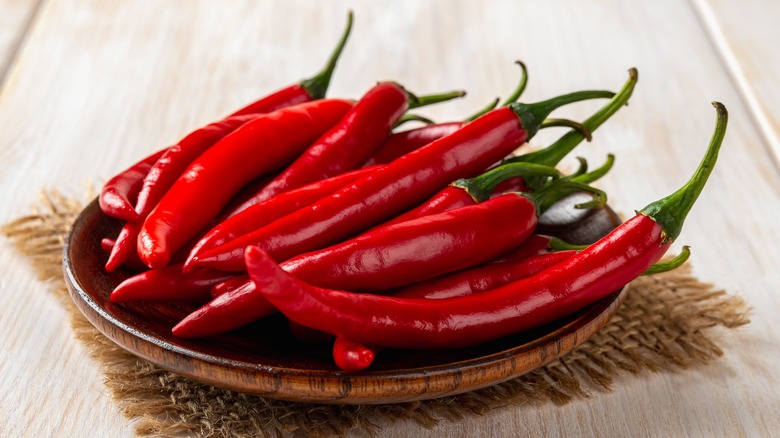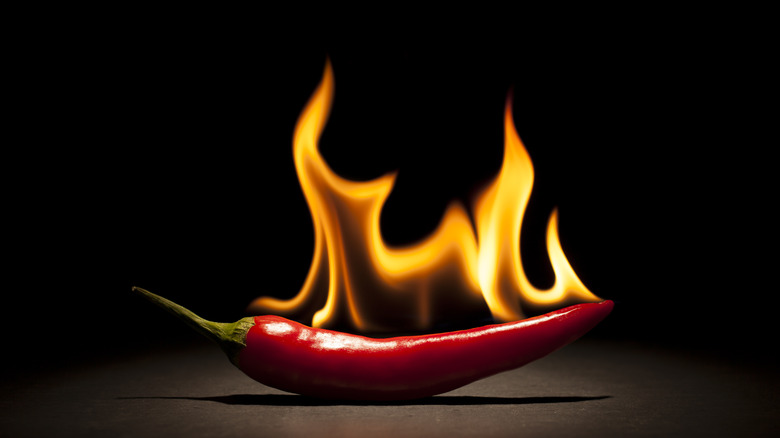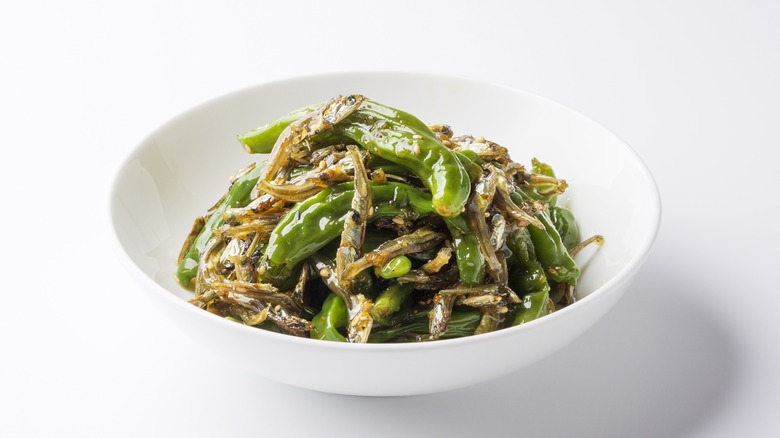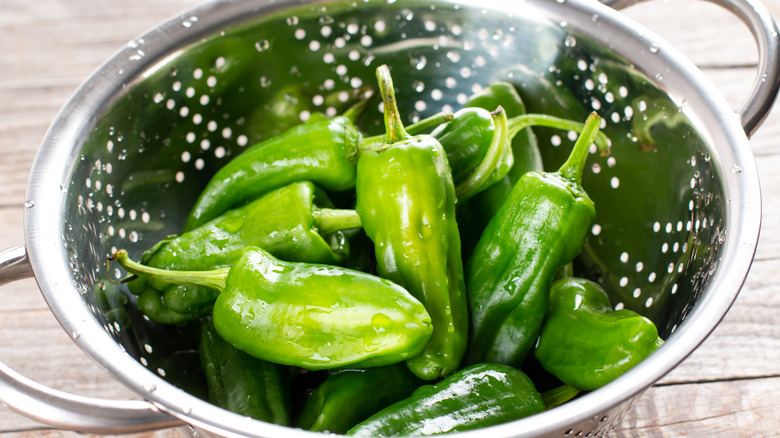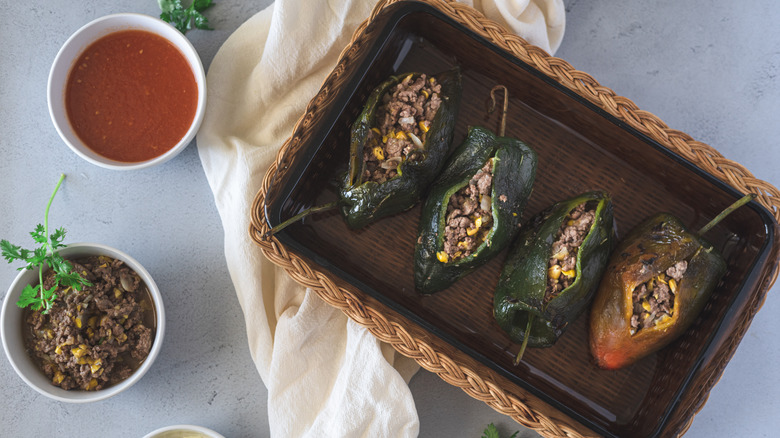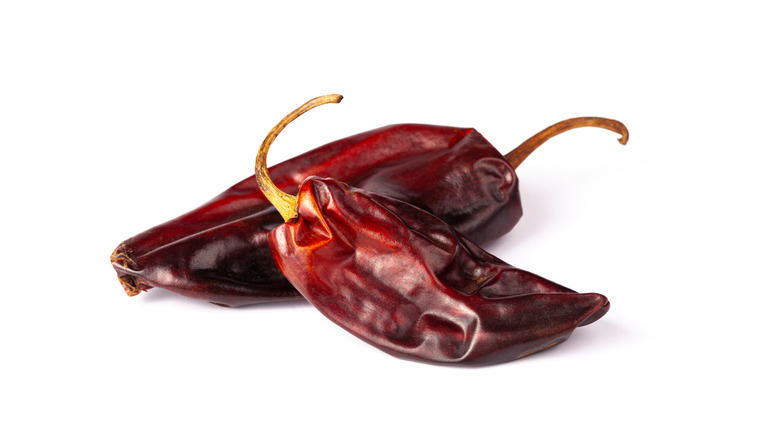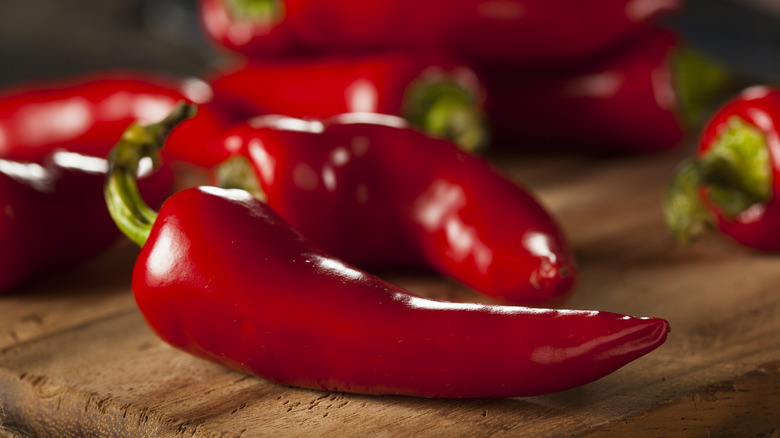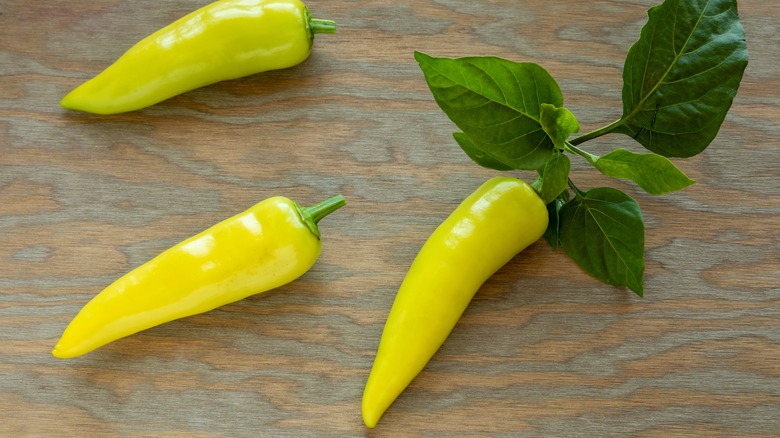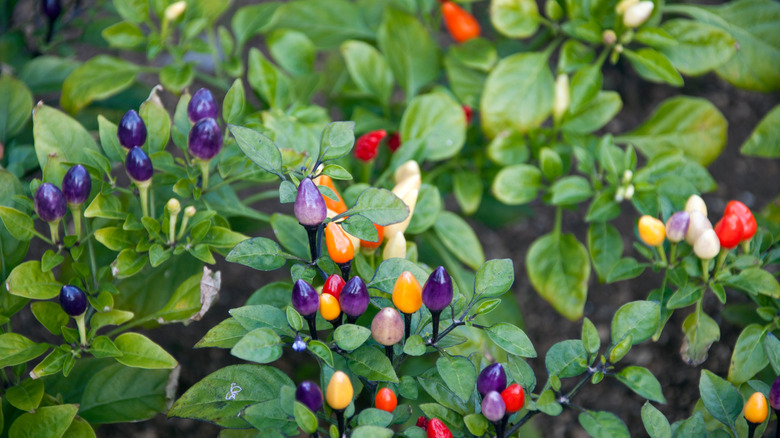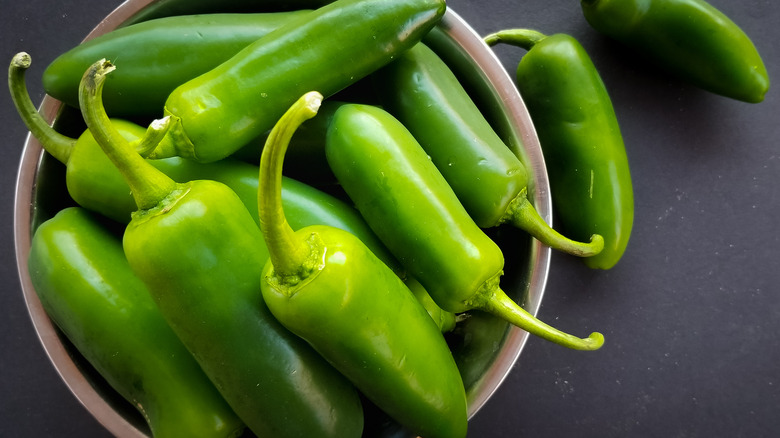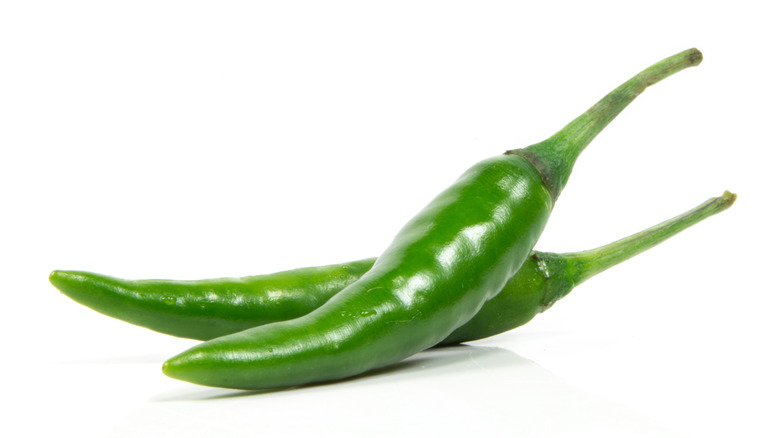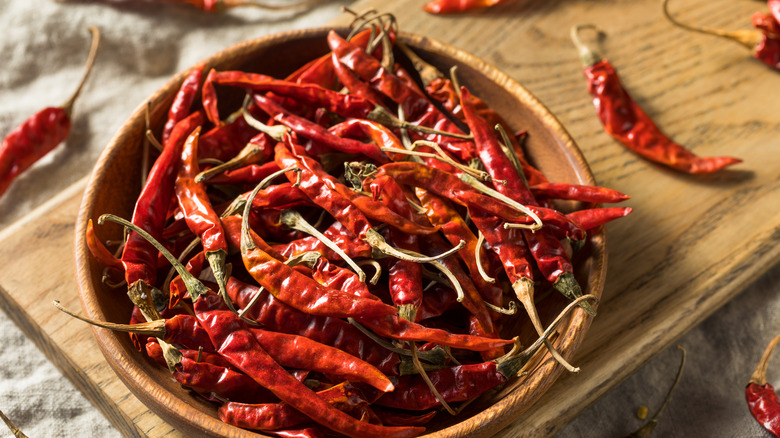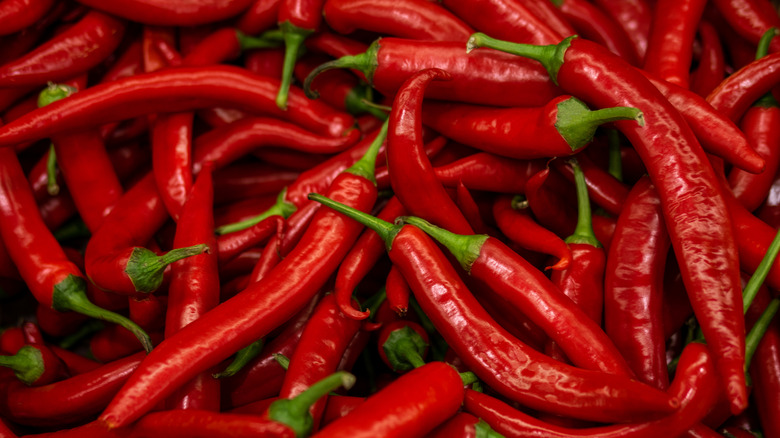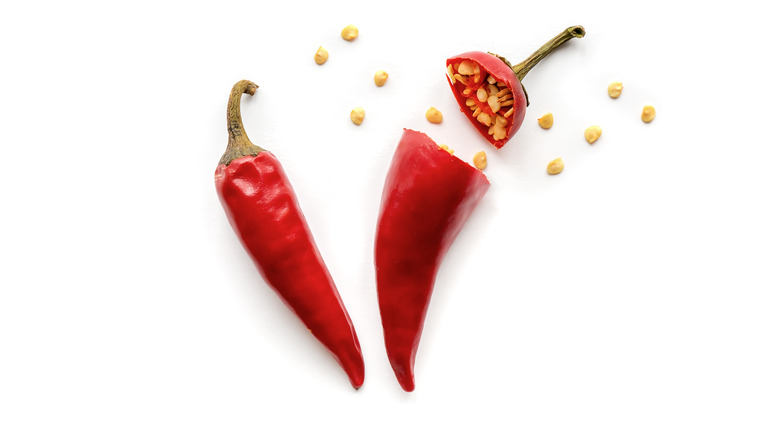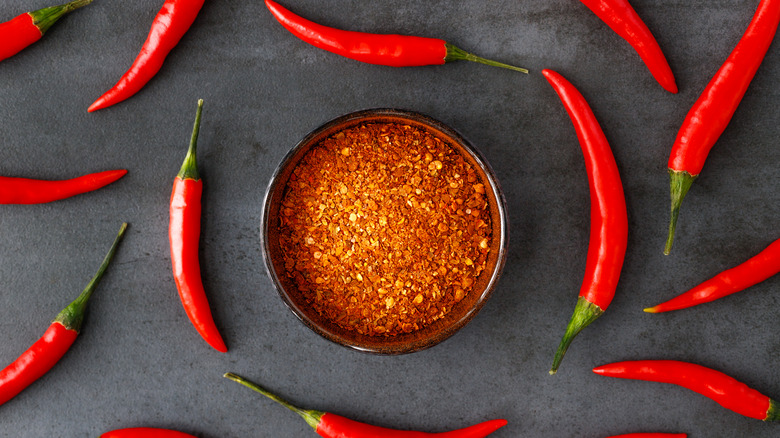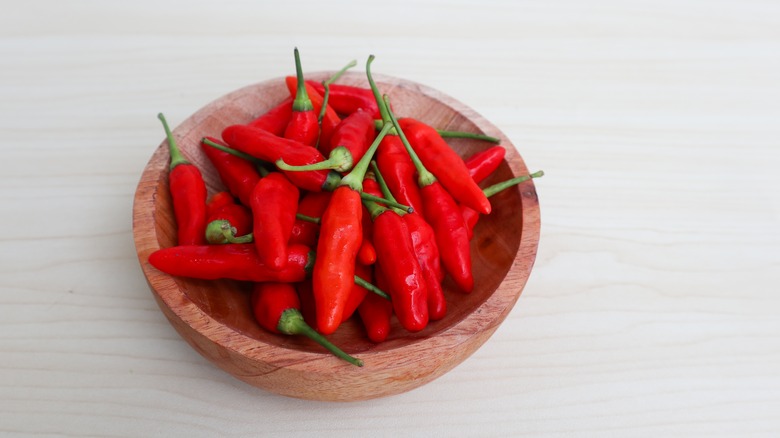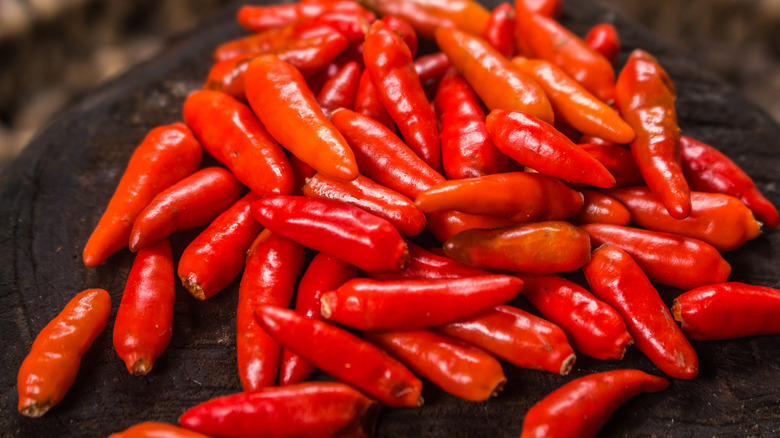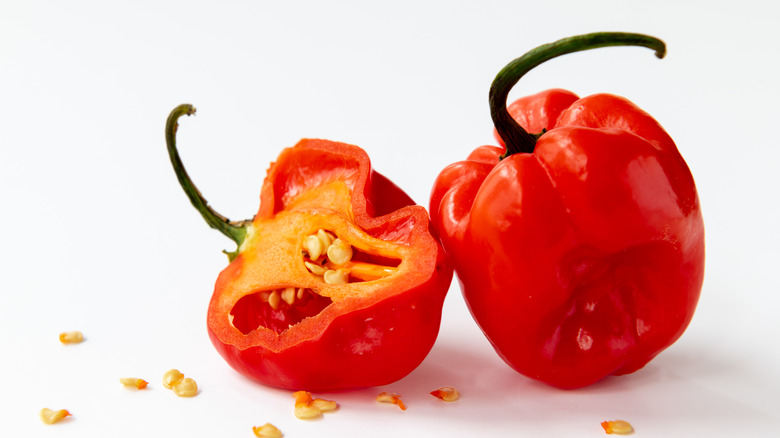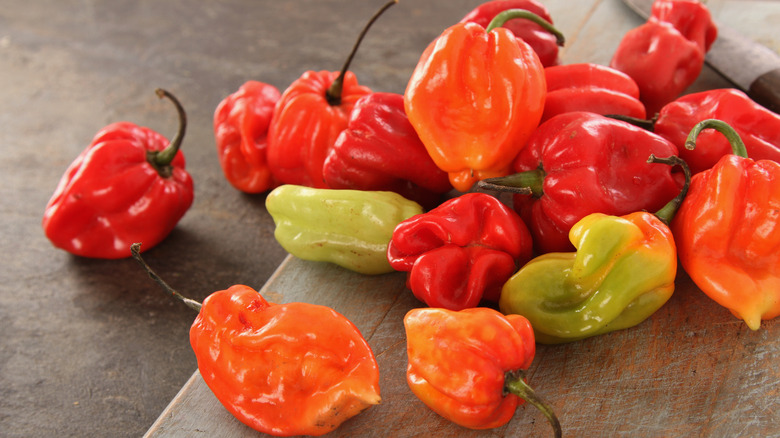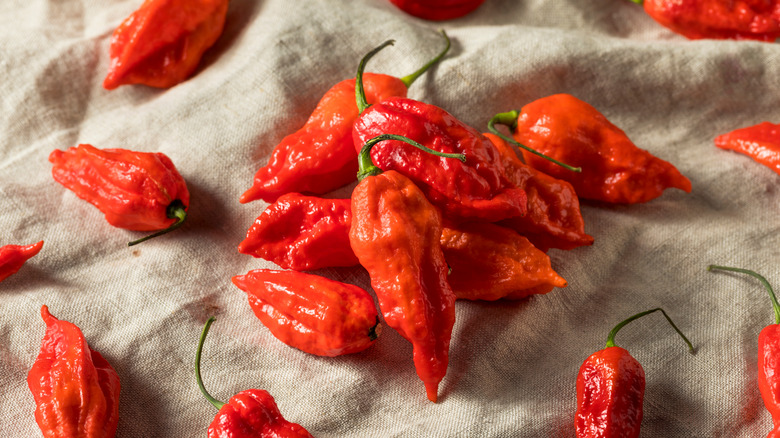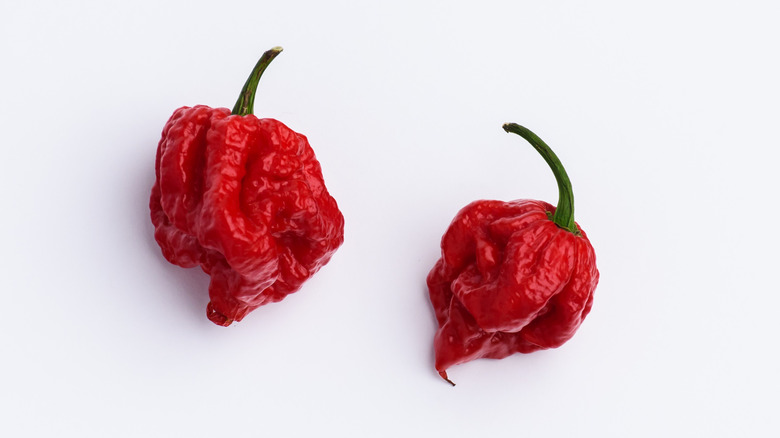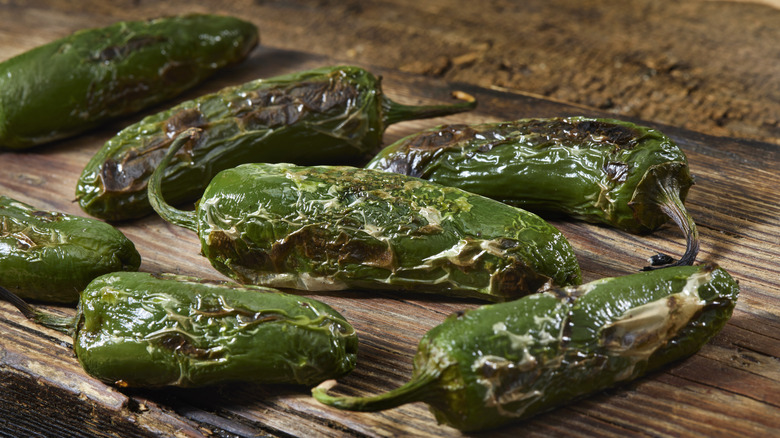21 Types Of Chile Peppers And How Spicy They Are
The planet is home to thousands of types of chilis: roughly 4,000 to be exact. Those thousands of individual chilis can be split up into five capsicum species and a further 28 wild varieties. New and hotter varieties are also constantly being developed. Chiles fall under the capsicum plant genus, which is what separates them from peppers, which are part of the piper genus. So, while you may have heard the term "chili pepper" or maybe even requested some "jalapeño peppers" on your burger, true peppers are actually a different thing entirely.
Not all chilis are hot either; their heat is determined by how much capsaicin oil they produce. Those that contain less capsaicin for their size are milder, while capsaicin-dense peppers will pack more of a punch. A chili's heat is measured in "Scoville units" with a higher number of Scovilles suggesting a hotter chili. Due to the great variety of chillies available, the small, spicy, fruits can be a great way to add heat to a dish. They aren't all about heat either, and many types of chili can be used to add a particular flavor profile to a menu item.
Chilis can add a much-need kick to a dish. Here are 20 of our favorites and where they fit on the Scoville spice scale.
A chili's heat is measured on the Scoville scale
Something like a bell pepper is completely capsaicin-free, has no spice whatsoever, and comes in at zero scovilles. On the other end of the scale, the Carolina Reaper is currently the world's hottest chili and comes in at 1.5 million Scovilles. A habanero (or scotch bonnet), which was the world's hottest chili up until 2006, clocks roughly 150,000 Scoville units. The popular jalapeño pepper comes in at 5,000 units or so. It is worth noting that a pepper's rating is approximate and individual chilis may measure a little lower or higher.
Some non-edible things can also be measured on the Scovile scale. Pepper spray is one of them, and measures around 5.3 million scovilles. This also means that the world's hottest chilis are surprisingly close to the point where someone may as well just blast themselves in the mouth with a chemical designed to cause incapacitating levels of pain — best to know what you're getting yourself into.
Shishito (Scoville: 200)
Shishito is a small and mild Japanese chili that tends to have a sweet flavor. Averaging around 200 Scoville units, its spice level is negligible and you should be able to eat them on their own most of the time without any issues — even if chilis aren't usually your thing. With that being said, there is a bit of a Russian Roulette element to eating shishitos.
Approximately one in 10 of the little green peppers will be far spicier than its siblings, and if one pepper is hot in a batch, it's likely that more will bring the heat as well. This still won't pose an issue for a seasoned spice connoisseur, but may make the uninitiated break out in a bit of a sweat. If you're planning on eating shishito peppers, it's best to blister them in a pan or a cast iron skillet first.
Padron (Scoville: 500 to 1,000)
Though beloved in Spain, where the emerald green, thin-skinned chiles are quickly charred and sprinkled with salt, Padrons are actually thought to have originated in Mexico. The peppers are almost always mild, but occasionally a spicy one will pop up.
Poblano (Scoville: 1,500)
Poblano chilis, which are also called ancho when found in their dry form, are a popular type of chili in Mexican cooking. At 1,500 Scoville heat units, they aren't the spiciest chilis you'll encounter and sit on the milder end of the spectrum. Still, there is a small amount of noticeable heat there, which will be more than enough for folks who don't have much of a spice tolerance.
Finding a roasted variant of these chilis is also pretty common, and you can roast them yourself. The roasted version is a good way to add mild spice and a smoky flavor to most Mexican and Tex-Mex dishes.
Mirasol/Guajillo (Scoville: 2,500 to 5,000)
Mirasol or guajillo chilis are a staple of Mexican cuisine and provide a moderately spicy kick. At 2,500-5000 Scoville units, they pack about the same amount of punch as a mild-to-medium jalapeño pepper. However, unlike jalapeños, Mirasol peppers are most often found in their dried "guajillo" form. They're also more likely to be used as a component in a Mexican or Tex-Mex dish than to be eaten on their own.
If the peppers aren't dried, then you'll want to use the freshest possible ones you can find. Older peppers, which may appear cracked or withered, won't do you any harm. They'll just pack far less flavor than a truly fresh chili.
Fresno: (Scoville: 2,500 to 10,000)
These petite chiles can be used fresh or canned, but they are not popular when dried due to their thick skin. Fresnos are delicious charred and added to romesco or minced and added to ceviche.
Hungarian Wax (Scoville: 3,500 to 10,000)
These banana-shaped peppers taste similar to jalapeños and grow up to six inches long. They originate in Hungary (no surprise there) and can be sliced raw and added to salads.
Bolivian Rainbow (Scoville: 5,000 to 30,000)
These tiny peppers grow to be around half an inch long and come in a multitude of colors. Though commonly sold to be ornamental, the chiles have plenty of heat and can be added to salsas for a dash of color.
Jalapeño (Scoville: 6,000 to 11,000)
A ubiquitous pepper loved across the U.S. and in Mexico, its fleshy skin can be sliced and added to just about anything. Jalapeños can also be marinated with vegetables and pickled like you see in escabeche. When ripened and smoke-dried, the chile transforms into chipotle peppers, which can be canned in adobo sauce or left dried and pulverized to a powder.
Serrano (Scoville: 10,000 to 25,000)
Widely available chiles that can be green or red, these small pungent peppers should never be used in place of jalapeños, as they can pack almost double the heat.
Chile de Árbol (Scoville: 15,000 to 30,000)
Similar in shape and size to its hotter cousin, the cayenne, the chile de árbol pepper is long and pointy, reaching up to two and half inches. It can be used both fresh and dry. Chile de árbol peppers have a slightly acidic quality, which makes them go well with tomatoes or salsas and other sauces, and can also be combined with fruit to make jam.
Cayenne (Scoville: 30,000 to 50,000)
This South American chile starts off green and then takes on a bright red hue. As it matures, the pepper's heat increases. It can be used fresh but is commonly dried and essential in Cajun cuisine. Sadly, most ground cayenne seasoning sold commercially does not exclusively use cayenne pepper but is made up of a mix of peppers.
Tabasco (Scoville: 30,000 to 50,000)
Rarely used in their fresh state, these peppers help make the iconic Louisiana-made hot sauce. Add a splash to your cocktail sauce if it needs some heat (it probably does!).
Thai Chile (Scoville: 50,000 to 100,000)
Known worldwide for their contribution to Southeast Asian cuisine, Thai chiles are called prik kee noo in Thai. That translates to "mouse dropping chile," a nod to the chile's tiny size. The chile is thin-skinned and has a pointed bottom and is essential to curries, stir-fries, and salads.
Bird's Eye (Scoville: 50,000 to 100,000)
There are technically two kinds of bird's eye chilis: an Asian variant popular in Thai cuisine and an African bird's eye chili that is most closely associated with piri-piri dishes. Both bird's eye varieties look different with the Asian pepper appearing more rounded and the African variant being quite similar to a finger chili. Despite the difference in looks, both pack a similar pungent flavor and are on the hotter end of the Scoville scale.
How hot exactly? It varies. But the average bird's eye chili will measure between 50,000 and 100,000 Scoville units. While this isn't as tongue meltingly intense as a Naga Scorpion or California Reaper, it's still more than enough to send the average person reaching for a glass of milk.
Piri Piri (Scoville: 60,0000 to 175,000)
Also known as bird's-eye chile or African devil, piri piri is a thin-skinned reddish orange chile. It is essential to Portuguese chicken recipes, even though the actual chile reigns from Africa.
Habanero (Scoville: 100,000 to 325,000)
A little goes a long way with this pepper, which has a slightly tapered, lantern-like tip. Its color can go from pale to medium green to bright orange and yellow. It can be charred and smashed into a paste with lime juice and salt or blended into an oil to add ample heat.
Scotch Bonnet (Scoville: 100,000 to 325,000)
Similar in shape to the habanero, Scotch bonnets are from the Caribbean and essential to jerk chicken. Their bulbous shape might make them look cute, but their heat is infamous and can last for a long time. However, their bright, tropical fruit notes make them easy to love.
Bhut Jolokia (Scoville: 1,000,000)
Commonly referred to as ghost chile, this pepper was at one point the hottest pepper in the world and received a great amount of attention for it. The pepper originates from India and should be used sparingly, as it can be quite overpowering when added to dishes.
Carolina Reaper (Scoville: 2,000,000)
The Carolina Reaper now holds the title of hottest pepper in the world. The pepper was bred in a greenhouse in South Carolina and is a cross between the red habanero and Pakistani Naga. It should not be eaten raw. Repeat: Do not eat a raw Carolina Reaper. (You're still going to, aren't ya?)
Here are some recipes that call for chili
Chilis are a useful ingredient. At a basic level, they can be an easy way to add spice to a dish. While not as scientifically exact as adding hot sauce, you can still get a good idea of just how spicy things are going to be when you add a few chilis. The exact level of spice can be controlled through your choice of chili, and the amount you're planning to add. The ingredient can also add various levels of pungency, fruitiness, or even smokiness depending on the variety you've selected. There is also a cultural element to using chilis in dishes. For example, certain African cuisines call for the use of bird's eye chili, Thai food uses Thai chili, and a lot of Caribbean dishes get their kick from a Scotch bonnet or habanero.
If you're looking for an excuse to play around with chili levels, our bison chili recipe uses chiles de árbol, guajillo peppers, and jalapeños. Adjusting the amounts of each, or leaving the seeds out, can affect the flavors and heat of the dish. You can have a similar experience with our chile Colorado recipe, and our red chile frito pie recipe also uses a variety of chilis to add both heat and flavor to the meal. Finally, if you truly want to center something on the spicy little fruit, then you should probably have a crack at our take on an oven-roasted chile rellenos with tomatillo salsa.
